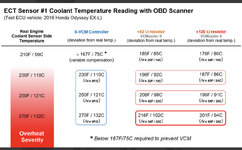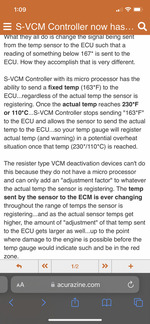Any Honda VCM disabling knowledgeable people here?
Likely buying a new Honda w/ v6 and VCM. I’ve never liked the idea of cylinders shutting down on anything. At least Honda doesn’t seem to have mechanical failures (lifters) that can still arise even if VCM is disabled. I know they clog up and get sticky piston rings, but if it’s disabled and well maintained I would think this is a non-issue.
My concern is all the VCM disables are simply skewing the coolant temp. I’ve tried to read up on it. Some claim they have a “processor” that tricks the coolant temp, but still relays the actual temp at the same time? I’m not techy, but sounds like some BS? How is it good for any modern computer controlled car to think engine temp is in the 160s all the time? In my mind that’s doing other harm, although obviously disabling the VCM which is the main point.
S-VCM and VCM Muzzler II claim they aren’t using a fixed resistor, that they have a logic and blah blah.
Are any of these VCM disablers legit? Would you use them on a new car? The advantage to S-VCM is it’s plug n play and could be removed in a matter of minutes for warranty work, but I don’t understand how it achieves its goal if it does (and doesn’t) skew the coolant temp readings all at the same time??
Just wondering if there’s any experts or anyone who understands this more that can shed some light. These guys on the Honda and Acura boards are just gung-ho “do it, add some Techron, and you’ll solve all your cars problems ever, even if it was burning 2 quarts per thousand miles, this will 100% fix it all”
Likely buying a new Honda w/ v6 and VCM. I’ve never liked the idea of cylinders shutting down on anything. At least Honda doesn’t seem to have mechanical failures (lifters) that can still arise even if VCM is disabled. I know they clog up and get sticky piston rings, but if it’s disabled and well maintained I would think this is a non-issue.
My concern is all the VCM disables are simply skewing the coolant temp. I’ve tried to read up on it. Some claim they have a “processor” that tricks the coolant temp, but still relays the actual temp at the same time? I’m not techy, but sounds like some BS? How is it good for any modern computer controlled car to think engine temp is in the 160s all the time? In my mind that’s doing other harm, although obviously disabling the VCM which is the main point.
S-VCM and VCM Muzzler II claim they aren’t using a fixed resistor, that they have a logic and blah blah.
Are any of these VCM disablers legit? Would you use them on a new car? The advantage to S-VCM is it’s plug n play and could be removed in a matter of minutes for warranty work, but I don’t understand how it achieves its goal if it does (and doesn’t) skew the coolant temp readings all at the same time??
Just wondering if there’s any experts or anyone who understands this more that can shed some light. These guys on the Honda and Acura boards are just gung-ho “do it, add some Techron, and you’ll solve all your cars problems ever, even if it was burning 2 quarts per thousand miles, this will 100% fix it all”
Attachments
Last edited:


